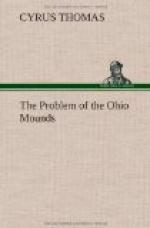So far, the modification consists in simply shortening the forward projection of the stem or base, the bowl remaining perpendicular. The next modification is shown in Fig. 6, which represents a type less common than the preceding, but found in several localites, as, for example, in Hamilton County, Ohio; mounds in Sullivan County, east Tennessee (by the Bureau); and in Virginia. [Footnote: Rau: Smithsonian Contributions to Knowledge, No. 287, p. 50, Fig. 190.] In these, although retaining the broad or winged stem, we see the bowl assuming the forward slope and in some instances (as some of those found in the mounds in Sullivan County, Tenn.) the projection of the stem is reduced to a simple rim or is entirely wanting.
[Illustration with caption: Fig. 6. Pipe from Hamilton County, Ohio.]
[Illustration with caption: Fig. 7. Pipe from Sullivan County, Tennessee.]
The next step brings us to what may be considered the typical form of the modern pipe, shown in Fig. 8. This pattern, according to Dr. Abbott, [Footnote: Prim. Industry, 1861, p. 329.] is seldom found in New England or the Middle States, “except of a much smaller size and made of clay.” He figures one from Isle of Wight County, Va., “made of compact steatite.” A large number of this form were found in the North Carolina mounds, some with stems almost or quite a foot in length.
[Illustration with caption: Fig. 8. Pipe from Caldwell County, North Carolina.]
It is hardly necessary to add that among the specimens obtained from various localities can be found every possible gradation, from the ancient Ohio type to the modern form last mentioned. There is, therefore, in this peculiar line of art and custom an unbroken chain connecting the mound-builders of Ohio with the Indians of historic times, and in the same facts is evidence, which strengthens the argument, disconnecting the makers from the Mexican and Central American artisans.
As this evidence appears to point to the Cherokees as the authors of some of the typical mounds of Ohio, it may be as well to introduce here a summary of the data which bear upon this question.
Reasons which are thought well-nigh conclusive have already been presented for believing that the people of this tribe were mound-builders, and that they had migrated in pre-Columbian times from some point north of the locality in which they were encountered by Europeans. Taking up the thread of their history where it was dropped, the following reasons are offered as a basis for the conclusion that their home was for a time on the Ohio, and that this was the region from which they migrated to their historic locality.
As already shown, their general movement in historic times, though limited, has been southward. Their traditions also claim that their migrations previous to the advent of the whites had been in the same direction from some point northward, not indicated in that given by Lederer, but in that recorded by Haywood, from the valley of the Ohio. But it is proper to bear in mind that the tradition given by Lederer expressly distinguishes them from the Virginia tribes, which necessitates looking more to the west for their former home. Haywood connects them, without any authority, with the Virginia tribes, but the tradition he gives contradicts this and places them on the Ohio.




